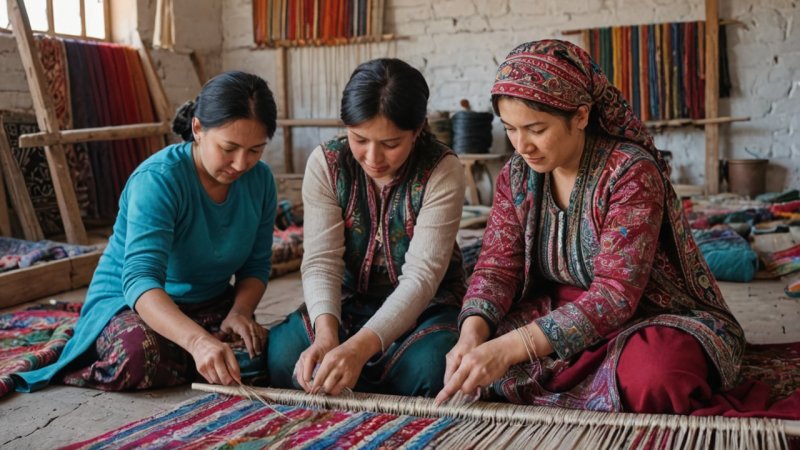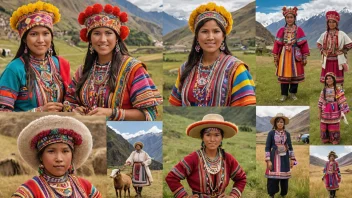The sun rises over the vast steppes of Central Asia, casting a golden hue over the intricate patterns that adorn the traditional textiles of the region. Weaving in Central Asia is not just a craft; it is a profound cultural expression that carries the weight of history, tradition, and identity. From the nomadic yurts of the Kazakh people to the vibrant bazaars of Uzbekistan, the art of weaving has played a vital role in defining social structures, economic stability, and cultural heritage. In this exploration of Central Asian weaving, we will delve into the techniques, symbolism, and the contemporary revival of this ancient art form.
The Historical Significance of Weaving
Weaving in Central Asia dates back thousands of years, intertwined with the very fabric of the region's history. The Silk Road, which connected the East and West, facilitated the exchange of not only goods but also cultural practices, including textile arts. The nomadic lifestyle of many Central Asian peoples influenced their weaving techniques, leading to the creation of portable textiles that were functional and beautiful.
In communities such as the Kazakhs, Tajiks, and Uzbeks, weaving was traditionally a woman's craft, passed down through generations. Each piece of woven textile tells a story, reflecting the values, beliefs, and experiences of the weaver and her community. The symbolism embedded in these textiles often represents nature, spirituality, and the social status of the family.
Techniques and Materials
The craftsmanship involved in Central Asian weaving is both intricate and diverse, showcasing a variety of techniques and materials. Traditionally, sheep's wool was the primary material used, valued for its durability and warmth. Over time, cotton and silk became more prevalent, especially in urban centers where trade flourished.
Common weaving techniques include:
- Flat Weaving: This method produces rugs and tapestries, characterized by bold geometric patterns.
- Pile Weaving: Used for carpets, this technique involves knotting the yarn to create a plush texture.
- Embroidery: Often combined with weaving, embroidery adds detailed designs to textiles, enhancing their visual appeal.
Each technique bears regional influences. For instance, ikat, a dyeing technique where the yarns are dyed before weaving, is prevalent in Uzbekistan, resulting in stunning patterns that seem to dance across the fabric. In contrast, the Kazakhs have mastered the art of felt-making, where wool is compressed and molded into durable carpets and clothing.
Symbolism in Weaving Patterns
Weaving in Central Asia is rich with symbolism, where patterns and colors convey specific meanings. The motifs often draw inspiration from nature, with elements such as birds, flowers, and trees representing freedom, beauty, and life. Additionally, certain geometric shapes are believed to carry protective qualities or bring good fortune.
For example, the “beshik” motif, resembling a cradle, symbolizes protection and is often used in textiles for newborns. Similarly, the “tumar” symbol, representing a talisman, is commonly integrated into clothing to ward off evil spirits. The vibrant use of color also plays a role, with red symbolizing happiness and prosperity, while blue is associated with spirituality and the sky.
Contemporary Revival and Preservation
In recent years, there has been a resurgence of interest in traditional weaving techniques across Central Asia. As globalization threatens to overshadow local crafts, artisans and cultural organizations are working tirelessly to preserve this invaluable heritage. Workshops and training programs are being established, attracting a new generation of weavers eager to learn and continue the traditions of their ancestors.
Furthermore, the integration of traditional designs into modern fashion has opened up new avenues for artisans. Designers are collaborating with skilled weavers to create contemporary pieces that honor traditional methods while appealing to global markets. This fusion not only supports local economies but also raises awareness about the cultural significance of weaving in Central Asia.
Experiencing Weaving Culture Firsthand
For travelers seeking to immerse themselves in Central Asian culture, engaging with local weaving communities offers a unique experience. Visiting workshops and artisan villages allows visitors to witness the weaving process up close, learn about the various techniques, and even participate in hands-on workshops.
In countries like Uzbekistan, cities such as Samarkand and Bukhara are renowned for their rich textile heritage. Here, you can explore vibrant bazaars filled with handwoven carpets, silk scarves, and embroidered textiles. Additionally, participating in festivals celebrating traditional crafts provides insight into the cultural importance of weaving and the stories behind each piece.
Moreover, travelers can contribute to the preservation of this art by purchasing textiles directly from artisans, ensuring that their craft continues to thrive in the face of modern challenges.
Conclusion
The art of weaving in Central Asian cultures is a testament to the region's rich history, cultural diversity, and artistic expression. Through intricate techniques, meaningful symbolism, and a commitment to preservation, the tradition of weaving continues to flourish, connecting generations and transcending borders. As travelers explore this vibrant aspect of Central Asia, they not only gain a deeper appreciation for the craftsmanship involved but also contribute to the ongoing narrative of a culture that values its heritage. Whether through visiting local artisans or engaging in workshops, the art of weaving offers a memorable and enriching experience that resonates long after the journey ends.






